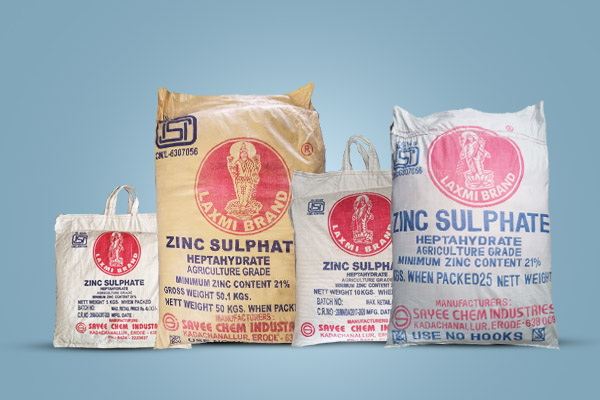14-B, Annamalai Layout,
Post Box No.905, Erode.
0424 2223637
Call us
Products
ZINC - An Essential Micro-element

Why is Zinc Important?
Zinc (Zn) is one among the seven micronutrient elements that is indispensable for plant growth. Its presence activates a series of enzymes responsible for maintaining the course and tempo of several vital growth events. Zinc asserts in protein synthesis and production of auxins (growth promoting chemicals). Therefore, a low zinc supply encourages protein deficiency and dwarfism in plants.
The net results of a zinc deficiency in soils are stunted crop plants, prolonged duration and poor yields. A severe deficiency can kill the crop.
What is Zinc Deficiency?
For optimum function of crop plants a certain minimum level of zinc supply is essential. If a soil, the principal resource from which plants draw their zinc needs, is unable to supply that minimum, a zinc deficiency situation arises. Such soils may contain large quantities of fixed Zn, but lack in a current supply that plants can readily encash to meet their ongoing needs. Soil Scientists often refer to this current supply as available zinc.
The minimum level of available Zn below which plant growth is impaired is called critical level. Soil that tests lower Zn than the critical. level grows zinc deficient plants. Researchers have established that atleast 50% of the Indian Soils suffer from certain degree of Zn deficiency. Zinc deficient soils abound in Uttar Pradesh, Haryana, Punjab, Madhya Pradesh, Maharashtra, Gujarat, Andhra Pradesh, Tamil Nadu and Bihar. High pH saline alkali soils, calcareous soils, low organic matter sandy soils are more frequently Zn deficient. Man's intervention leading to loss of fertile surface soil or indiscriminate use of certain chemical fertilizers (specifically phosphatic) can aggravate Zn deficiency condition.
Can Zn Deficiency be Recognized in Growing Plants?
YES, Zn deficiency in growing plants can be recognized by visual symptoms and by making analysis of plant tissue far Zn concentration.
Zinc deficiency provokes abnormal metabolic signals in plants leading to certain visible symptoms. In fact, development of visual symptoms can be a guide to diagnose Zn deficiency. Mast often Zn deficiency symptoms are seen an leaves. Their occurrence on other plant organs (mats or stems) is not completely ruled out. Different crop plants produce different symptoms (as illustrated in later sections). Zinc deficiency symptoms common to many crop plants are described hereunder:
| • Development of abnormal spats (light green, yellow, bleached 0.1' brown rusty spats)an the leaves. |
| • Very small leaves at the shoot tip producing a bushy rosetted appearance. |
| • Dwarfism due to shortening of stalk internodes. |
| • Stunted growth, unhealthy looks. |
| • Death of affected tissue, uneven crop stand. |
| • Delayed maturity. |
Plant tissue tests far Zn can establish a Zn deficiency or otherwise. Whenever, Zn content in plants is sub-optimum, plants fail to put up normal growth despite recommended application of nitrogen, phosphate and potash fertilizers. As a rule of thumb, plant Zn concentrations less than 20g per ton of dry tissue suggest probability of deficiency, and concentrations of less than 15 g per ton of dry tissue indicate definite deficiency.
